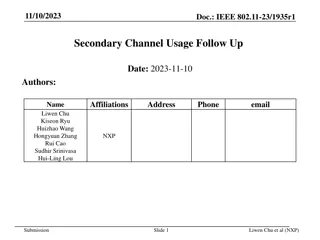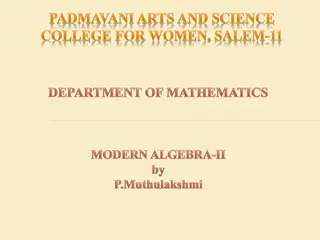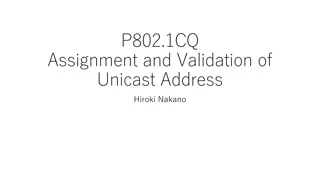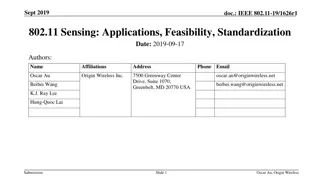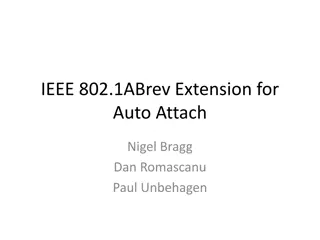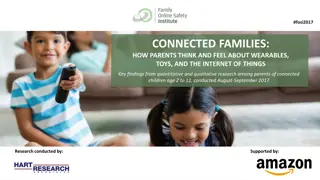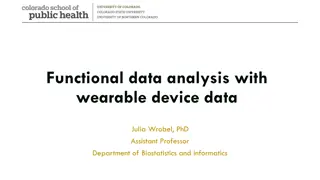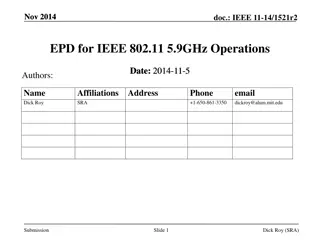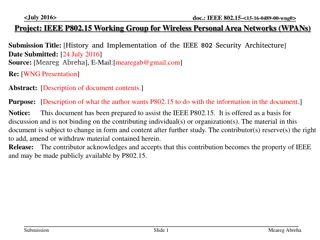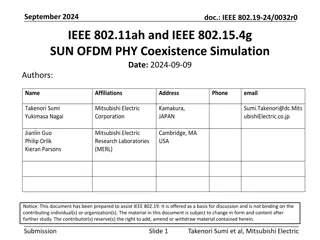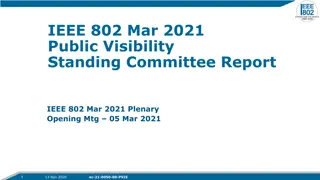IEEE 802.11-15/624r0: High-end Wearables in Public Spaces Usage Model
This document introduces a usage model focusing on high-end wearables in public spaces for 11ay, discussing the emerging trends, requirements, and differences from existing use cases. It explores the challenges of dense device environments and the potential of wearables to redefine mobile content consumption.
Download Presentation

Please find below an Image/Link to download the presentation.
The content on the website is provided AS IS for your information and personal use only. It may not be sold, licensed, or shared on other websites without obtaining consent from the author.If you encounter any issues during the download, it is possible that the publisher has removed the file from their server.
You are allowed to download the files provided on this website for personal or commercial use, subject to the condition that they are used lawfully. All files are the property of their respective owners.
The content on the website is provided AS IS for your information and personal use only. It may not be sold, licensed, or shared on other websites without obtaining consent from the author.
E N D
Presentation Transcript
C-DOT-TSDSI Webinar Series: The National Standards for IoT Smart Cities Perspective Technical Session oneM2M Release 4 : Preview of new features By Poornima Shandilya C-DOT
Highlights of new features Action triggering Semantic reasoning Discovery Based Operations Geo query Attribute based access control policy Primitive profile End to End QoS session (3GPP network) Network congestion Monitoring (3GPP network) Time Management Software campaigning Process Management Service subscriber and user Resource Synchronization Retargeting via Resource mapping rules Modbus interworking
SDS Work items (WI) For Release 4 Work Item Title Release 4 Feature Related TS/TR WI-0053 Enhancement on semantic Support Semantic Reasoning TS-0034/TR-0033 WI-0058 Interworking with 3GPP Networks End to end quality of session and network monitoring request TS-0026 WI-0072 Modbus Interworking Modbus interworking TS-0040/TR-0043 WI-0076 Lightweight oneM2M services Primitive profile TS-0001/TR-0053 WI-0077 Attribute based Access control policy Attribute based access control policy TS-0001/TR-0050 WI-0080 Edge and Fog Computing Resource synchronization, software campaigning TS-0001/TR-0052 WI-0083 oneM2M Service Subscribers and Users Service users and profile restrictions TS-0001/TR-0053 WI-0089 Getting started with oneM2M High level description of oneM2M features TR-0057 WI-0093 Action Triggering Enhancements Process Management TS-0001/TR- 0021/TR-0063 Complete On track
Common Service Entity (CSE) New Enhanced
Application Entity (AE) Application Entity Application Service logic actuator AE Headend AE Mobile AE Gateway Sensor AE AE resides on the application layer. Configurator AE- creates some configurations on CSE Monitoring/Controlling AE- sends command to control devices or to monitor the details IPE- Interworking Proxy Entity- enables integration of non-onem2m system into onem2m
Action Triggering Action Triggering To monitor events and take actions on behalf of application based on preconfigured conditions Water Sensor Application (AE 1) value > x Configurator Application (AE) OneM2M Common Service Entity (CSE) Defines actions and dependencies for water meters Check if value is less than or equal to x and notify the actuator application Actuator Application (AE 2) pulse the relay for 50ms whenever value <=x
Process Management Enables management of states and actions Value should be in range x-y Sensor Application (AE 1) Configurator Application (AE) OneM2M Common Service Entity (CSE) Defines process and states for actions Action 1 Actuator 1 Application AE 2(heating) Process- Enable, Disable, Pause, Reactivate if value <x state x Action 1 (heating) if value is >y state y Action 2 (cooling) Action 2 Actuator 2 Application AE 3(cooling)
Semantic Reasoning Purpose-to derive new relations/knowledge that are not explicitly expressed in the existing knowledge/facts. Feature Description-: A Semantic Reasoning Function (SRF) is defined at Hosting CSE, consisting of reasoning rules set which are applied onto the existing Semantic data (Fact set). How-Configuration of semantic reasoning related data (Reasoning rule set, Fact set) at CSE for different application needs. By leveraging the outputs of semantic reasoning (i.e., reasoning result), the CSE will further produce the optimal result for the semantic operation.
Semantic Reasoning oneM2M CSE Knowledge Base Camera is-located-in Building 1 Discover all cameras which monitors rooms in Zone1 Camera sensor (AE 1) Knowledge base Sends data Smart city Application (AE) Building 1 is-managed- under Zone1 Camera located successfully Building 1 (AE 2) Sends data Reasoning Rule: Semantic Reasoning IF X is-located-in Y && Y is-managed-under Z, THEN X monitors- room-in Z
Discovery Based Operations To perform a single request to be executed on a discovered set Light Application AE 1 Label=room1 Monitoring/Con trolling Application (AE) ON OneM2M Common Service Entity (CSE) Switch on devices with label room 1 Light ON Application AE 2 Label=room1 Performs discovery to find AE with label=room1 Changes the light state in CSE for AE with label=room1 Sends notification to switch ON all AE with label=room1 Light Application AE 3 Label=room2
Geo Query Feature Purpose- to get the details of applications/sensors location wise Feature Description: The Geo query feature enables oneM2M system to support geometry objects (e.g. Point, Polygon) to represent the geo- location of a M2M Device, M2M Gateway and a Thing How- oneM2M service layer is enabled to store/retrieve latitude, longitude coordinates of various IoT devices.
Primitive Profile Feature Purpose- to reduce the size of messages flowing back-and-forth between an Originator (e.g. AE) and a CSE. Feature Description: defines a message template to be applied to requests and responses that CSE receives or generates. How- Configuration of message template at CSE for a set of IoT devices and modify the message to/from applications as per this template
Primitive Profile Feature AE 1 Sensor1 sends data Configurator Application (AE) OneM2M Common Service Entity (CSE) ate templ ate templ Configures primitive profile for set of applications Sensor2 sends data AE 2 Multiple message templates are configured at CSE. Actuator AE receives notification AE 3
End-to-End QoS session (3GPP Interworking) To establish a data session with a specific QoS and priority handling. OneM2M Common Service Entity (CSE) Configurator Application (AE) SCEF 3GPP Network 2. QOS Session Subscription 1. Configures e2eQOSSession at IN-CSE Application (AE1) Sends request Targeting session end point (AE1) QoS session is established and request is delivered with required QoS Application (AE2)
Network Congestion Monitoring (3GPP IWK) To request network status information from an Underlying Network 1. Configures Network Monitoring request and subscription for it 2 Monitoring request OneM2M Common Service Entity (CSE) Configurator Application (AE) SCEF 3GPP Network Monitoring response with info such as congestion level, location AE 1 Gets notification for network status e.g. HIGH congestion in Mehrauli area AE 2 AE 3 Detects congestion AE 2 AE n Location = Mehrauli, New Delhi
Time Management Purpose-Allows time synchronization with the Hosting CSE absence of which may lead to request rejection and storage of inconsistent data Feature Description Time synchronization beacon is configured at the CSE with the details notification targets who want to have time synchronization with the CSE. How-achieved through beacon notifications Hosting CSE sends beacon notifications periodically based on an interval or on loss of synchronization (calculated based on predefined threshold value).
Time Management Configures URI of AE2 for time sync beacon notification Sends request with originating Timestamp=2pm OneM2M Common Service Entity (CSE) Current time= 3 PM CSF AE 1 Configurator Application (AE) TMG Time =2 PM Synchronizes time for this request from AE 1 Sends time sync beacon notification to AE 2 AE 2 Receives beacon notification for time synchronization Time =4 PM
Software Campaigning Purpose-Provides policies and rules for the management of software by a Hosting CSE Feature Description- Triggers a CSE to install, uninstall, activate or deactivate software on IoT devices. How- An AE can configure software campaign on a CSE to instruct the CSE to manage the software versions on field devices on the AE's behalf.
Software Campaigning Install/uninstall/ac tivate/deactivate software on AE-1 and 2 AE 1 Configurator Application (AE) OneM2M Common Service Entity (CSE) Configures software campaigning to manage software on AE-1 and 2 AE 2
Service subscriber user and profile restrictions Sends request as per its service subscription profile AE 1 Configurator Application (AE) OneM2M Common S Service Entity (CSE) Configures subscriber, users, service subscription profile for an M2M Application Provider SSM Sends request not as per its service subscription profile AE 2 Allows SSP to be linked with the subscriber and users Checks for presence of a valid and ACTIVE service subscription Applies restriction as per its service subscription on incoming request such as request rate, max NumContainer etc. success failure
Modbus interworking Allows Modbus devices to interwork with oneM2M system and represented as oneM2M devices Modbus device 1 Monitoring/Con trolling Application OneM2M Common Service Entity (CSE) Controls modbus devices without being aware of modbus technology Modbus device 2 IPE Registers and represents modbus devices as oneM2M resources on CSE Controls modbus devices Modbus device n
Retargeting via resource mapping rules Purpose- to allow a Hosting CSE to retarget oneM2M CRUD requests towards resources hosted by AEs. Feature Description-many existing technologies such as OCF, LWM2M, ZigBee Smart Energy 2.0, etc. are RESTful in nature and are based on the premise that the devices themselves host their own local resources which can be targeted by CRUD requests. Resource mapping rule will allowing mapping of these resources in CSE and retargeting of CRUD requests to them. How- It is achieved by defining the mapping rules and targeting procedures in CSE.
Retargeting via resource mapping rules Configurator Application (AE) OneM2M Common Service Entity (CSE) Configures resource mapping rules for OCF devices OCF device IPE




